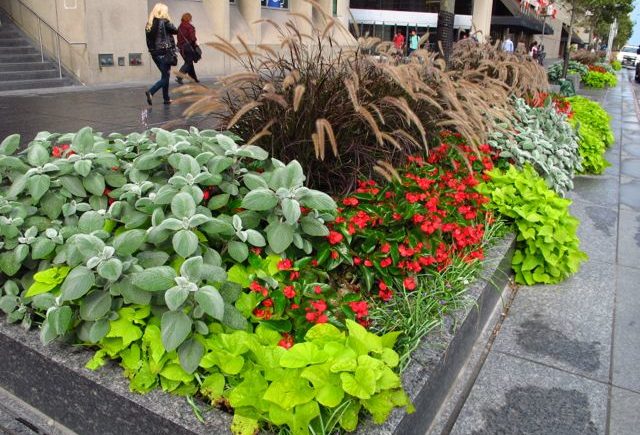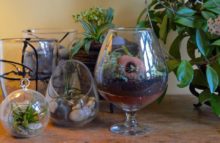 |
| The Bloor Street Transformation Project included granite planters and about 130 London plane trees |
Overspilling with colour, the new granite planters on chi-chi Bloor Street are hard to miss. But did you also notice the trees?
These pix from September were meant for a post I’d wanted to call a Bloor Street Garden Tour (it might still happen). But today’s rain reminded me that one of that day’s photo subjects was mentioned earlier this month at 2013’s Master Gardener Technical Update on Water-Wise Gardening. Given our recent hot, dry weather, water wisdom is becoming an essential skill.
Which takes me back to trees; more than 130 new ones on Toronto’s “mink mile,” thanks to Bloor Street’s $25 million transformation project. Trees are the biggest plants in your garden with, inch for cubic inch, the biggest thirsts, especially new ones trying to put down roots. One way the Bloor Street project ensured its new trees would survive* was by using Treegators. You can, too.
At the time, I thought the Treegator below was cool enough to photograph. Hearing it mentioned at the tech update, was an aha!
moment. If you’re babysitting a new street tree, or want to give a tree
on your property a good start, this would be a great tool. Its
20-gallon capacity slowly dispenses over 5-9 hours – longer than you’d
ever leave a hose on for – right at the root zone, with limited
run-off.
 |
| Treegator is a slow-release watering system that zips around the base of newly planted trees. |
Toronto’s aging urban forest needs all the new trees it can get. Surprisingly, the majority – 60 percent of the city’s 10.2 million existing trees – are on private property; your yard and mine. We need to replace expired trees and add new ones to grow our urban canopy, and the City will look to us for active stewardship. With more extreme weather on the horizon, a tool like this could be a time-saver and a tree-saver.
According to the company website, the 20-gal. Treegator (there’s a 15-gal. Treegator Jr.) is available from Toronto-area suppliers for about $22: Rittenhouse in St. Catherines; and Sheridan Nurseries (not listed in the products on its website, so best ask).
I have no affiliation with the manufacturer nor the suppliers. But I do love trees.
(*An extensive Silva Cell system beneath the street and sidewalk on Bloor Street also allows for a significantly larger root system than our typical street trees. Street trees like the ones you see pinched into tiny cement boxes or crammed into the small gaps between gravel on the sidewalk have an average lifespan of about 7 years. Seven years! Many trees die in their first two years due to lack of maintenance.Not only is that a sad loss, it’s an expensive one. )





9 comments
We used the tree gators for some trees we planted in VA. Some worked well and some leaked out all the water in short order. I do like the idea of keeping trees well hydrated when newly planted.
Good to know, Janet. Could you tell on examination why the ones failed?
Not that I recall Helen.
Hi Helen,
good to know that these gators are available to the public as I thought only municipalities, via their contractors, had access to them. Now if we could see the elimination of volcano mulching as a "best practice", newly planted trees would have a greater chance of survival!
I'm with you on the mulch volcanoes, Paul. I posted some horrifying pictures on our Toronto Gardens Facebook page back in March.
I first saw treegators in the display gardens at Michigan State University about 5 years ago. The instructor that was showing us master gardeners around, said that sometimes the water holes would clog up but by ocasionally tugging them by the handles at the top, it would shift the plastic around and free them up letting the water flow again.
Interesting. Thanks, Jill.
Transformation project? I like the sound of it. I would love to transform my entire neighborhood, not enough people around here are green thumbs Helen.
-Evergreen Tree & Shrub Inc.
Well, the transformation project was largely funded by the Bloor and Yorkville Business Improvement Association of merchants wanting to keep up the tone of the area. But every resident of the city is an independent member of an unofficial neighbourhood improvement association – and we can all pitch in to make our nabes greener.